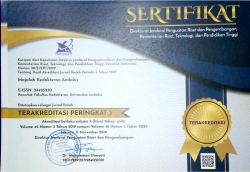ATRESIA BILIER
Abstract
Abstrak
Atresia bilier merupakan penyakit yang jarang terjadi dan penyababnya belum diketahui secara pasti. Karakteristik dari penyakit ini adalah terjadinya inflamasi progresif pada duktus bilier sehingga terjadi obstruksi ekstrahepatal yang akhirnya dapat menyebabkan fibrosis dan sirosis hepar. Atresia bilier ada 2 tipe yaitu: 1.) Syndromic atau fetal, disertai beberapa kelainan kongenital (10-20%). 2.) non syndromic, tanpa disertai kelainan kongenital yang lain (80-90%). Atresia bilier akan berakibat fatal tanpa penanganan yang cepat. Kelainan ini dapat ditangani dengan metode operasi Kasai prosedure yang dapat mengalirkan kembali aliran empedu hampir 80% jika dilakukan secepatnya, gold periode >60 hari. Diagnosis dini sangat penting untuk keberhasilan operasi Kasai. Pada penulisan ini akan dilaporkan sebuah kasus atresia bilier tipe fetal, seorang anak laki-laki berusia 58 hari, dengan keluhan tampak kuning sejak usia 3 minggu disertai dengan buang air besar berwarna pucat, buang air kecil berwarna seperti teh pekat. Diagnosis ditegakkan berdasarkan gejala klinis, laboratorium, USG dan biopsi hepar yang sangat mendukung diagnosis atresia bilier. Operasi Kasai tidak efektif karena disertai dengan komplikasi kholangitis yang akhirnya menyebabkan sirosis hepatis pada 5 bulan kehidupan.
Kata kunci : Atresia bilier, Kasai procedure, kholangitis, sirosis hapatis
Abstract
Biliary atresia is a disease of unknown etiology, characterized by progressive fibro inflammatory of the bile duct and liver that result obstruction of extrahepatic bile duct, leading to the fIbrosis and liver cirrhosis. It has two form of biliary atresia : 1.) syndromic of fetal biliary atresia (10-20%) with various congenital anomalies, 2.) non syndromic biliary atresia (80-90%) with isolated anomaly. In this case we report on an infant with the second form of biliary atresia, with diagnosis and operation was not based on liver biopsy, but on clinical features, laboratorium finding and USG, that were a highly suggestive of fetal form of biliary atresia. A boy 58 days infant with fetal biliary atresia. He developed jaundice in 3 weeks of life, pale stool, dark urine, and liver was palpable. Kasai operation was not effective because he had cholangitis complicated and developed liver cirrhosis at five month of age. Fetal EHBA (Extra Hepatic Biliary Atresia) with worse outcome after Kasai procedure because
LAPORAN KASUS
189
of cholangitis complicated. Early diagnosis EHBA is very important for succesfull of Kasai procedure.
Key words: biliary atresia, kasai, Cholangitis, liver cirrhosis





















